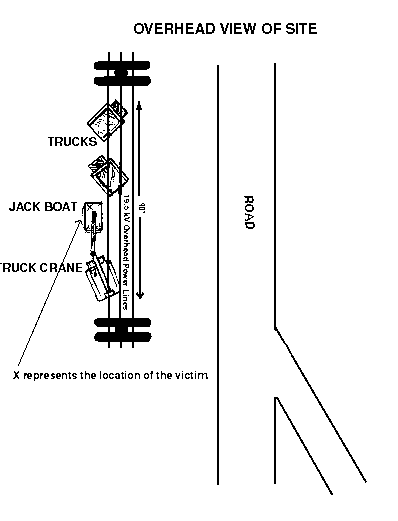Laborer Electrocuted in Virginia
FACE 87-61
Introduction
The National Institute for Occupational Safety and Health (NIOSH), Division of Safety Research (DSR) is currently conducting the Fatal Accident Circumstances and Epidemiology (FACE) Project, which is focusing primarily upon selected electrical-related and confined space-related fatalities. The purpose of the FACE program is to identify and rank factors that influence the risk of fatal injuries for selected employees.
On July 21, 1987, a laborer/truck driver was collecting scrap metals from property owned by a local municipality. He was grasping the hook suspended from the hoist cable of a truck crane when the hoist cable contacted an overhead high voltage line. He provided a path to ground and was electrocuted.
Contacts/Activities
Officials of the Occupational Safety and Health Administration (OSHA) for the Commonwealth of Virginia notified DSR concerning this fatality and requested technical assistance. This case has been included in the FACE Project. On August 13, 1987, a DSR research team (safety specialist and research industrial hygienist) met with the company owner/manager and interviewed one comparison employee. Photographs of the site were taken.
Overview of Employer’s Safety Program
The employer is a small company that specializes in collecting and removing scrap metal from shipyards and industrial, commercial, and public operations. The company usually has six to eight full-time employees and has no safety program. Only minimal on-the-job training is provided and there is little evidence that personal protective equipment (PPE) is used or available.
Synopsis of Events
The weather on the day of the accident was clear and hot. The temperature was approximately 95 degrees Fahrenheit. Two trucks and the truck crane were at the site (see figure). The two trucks were positioned for loading under the power lines. The truck crane was operating close to the power lines in order to pick up a “jack boat” made of plate steel. The victim (location X) was a truck driver, but was also working as a “hook-on man” helping the crane operator load the scrap metal, which was a common practice for this company.
As the victim stood on the “jack boat” holding the cable hook, the boom cable of the crane contacted a 19,900 volt overhead power line. The victim provided a path to ground for the current and was electrocuted. The power line burned and separated, falling onto the trucks and starting a fire. Both the emergency medical service (EMS) and the fire department were called, but the victim was pronounced dead at the scene.
Cause of Death
The medical examiner’s report stated that death was due to “accidental electrocution.” Entrance burns were noted on the victim’s right hand and exit burns were present on his right foot. Electrical arc burns were seen on the trunk, left upper extremity, and both lower extremities.
Recommendations/Discussion
Recommendation #1: Employers should enforce existing regulations concerning crane operations in the vicinity of overhead power lines.
Discussion: OSHA Standard 1910.180(J)(1) requires that a minimum clearance of ten feet be maintained between parts of cranes or loads and electrical power lines rated 50 kV or less, unless the lines were de-energized and visibly grounded or insulating barriers are erected.
Recommendation #2: Employees should be trained in hazard recognition.
Discussion: Employees working in the vicinity of power lines should be trained to recognize electrical hazards. The employer generally did not conduct any safety meetings. Daily safety meetings should be conducted by employers. During these meetings employees should be made aware of all hazards associated with the tasks to be performed during the day, including electrical hazards.
Recommendation #3: Additional personnel should be used to observe clearances when equipment is being operated in the vicinity of electrical power lines, especially if the operator’s visibility is impaired in any way.
Discussion: Employers should designate an observer for all operations where it is difficult for the operator to maintain desired clearances by visual means. The accident occurred just before noon, and the sun may have made it difficult for the operator to adequately judge the clearance. The use of an observer might have prevented the accident.

Figure. Overhead View of Site
